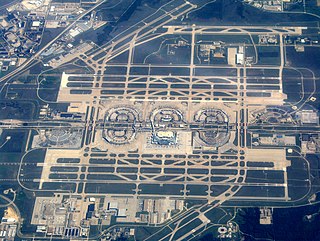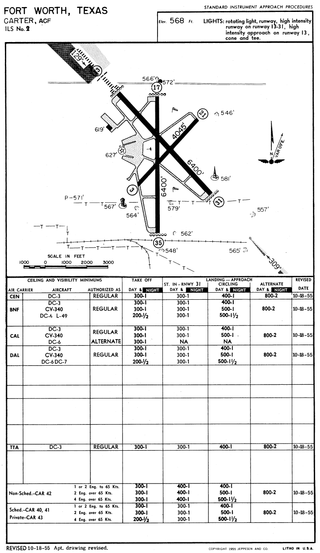Related Research Articles

Dallas/Fort Worth International Airport, also known as DFW Airport or simply DFW, is the primary international airport serving the Dallas–Fort Worth metroplex and the North Texas region of the U.S. state of Texas.

Corpus Christi International Airport is 6 miles west of Corpus Christi, in Nueces County, Texas. It opened in 1960, replacing Cliff Maus airport at 27.767°N 97.44°W, where the Lozano Golf Center is now located.

Lubbock Preston Smith International Airport is five miles north of Lubbock, in Lubbock County, Texas, United States. Originally Lubbock International Airport, it was renamed in 2004 for former Texas governor Preston E. Smith, an alumnus of Texas Tech University.

Braniff Airways, Inc., operated as Braniff International Airways from 1948 until 1965, and then Braniff International from 1965 until air operations ceased, was an airline in the United States that flew air carrier operations from 1928 until 1982 and continues today as a retailer, hotelier, travel service and branding and licensing company, administering the former airline's employee pass program and other airline administrative duties. Braniff's routes were primarily in the midwestern and southwestern United States, Mexico, Central America, and South America. In the late 1970s it expanded to Asia and Europe. The airline ceased air carrier operations in May 1982 because of high fuel prices, credit card interest rates and extreme competition from the large trunk carriers and the new airline startups created by the Airline Deregulation Act of December 1978. Two later airlines used the Braniff name: the Hyatt Hotels-backed Braniff, Inc. in 1983–89, and Braniff International Airlines, Inc. in 1991–92.
Jeffrey R. Chodorow is an American restaurateur, lawyer and financier.

The Wright Amendment of 1979 was a United States federal law that governed traffic at Dallas Love Field, an airport in Dallas, Texas, to protect Dallas Fort Worth International Airport (DFW) from competition. The amendment—enacted in reaction to the refusal of Southwest Airlines to vacate Love Field and move to DFW—prohibited carriers from operating full-size airliners between Love Field and destinations beyond Texas and its four neighboring states. Further amendments in 1997 and 2005 added new states and relaxed aircraft rules for longer range service. The law was partially repealed in 2006 and then fully repealed in 2014.

Brownsville/South Padre Island International Airport is 5 miles east of downtown Brownsville, Cameron County, Texas.

Wichita Falls Regional Airport is a public and military use airport six miles north of Wichita Falls in Wichita County, Texas. Its runways and taxiways are shared with Sheppard Air Force Base; most operations are military, but American Eagle flies to Dallas/Fort Worth International Airport.

Legend Airlines was an airline headquartered at Dallas Love Field in Dallas, Texas, United States. Legend operated nonstop flights from its Love Field hub to Washington D.C., Las Vegas, Los Angeles and New York City, the first carrier to fly from Love Field to destinations beyond the Wright Amendment five-state region after the opening of Dallas/Fort Worth International Airport in 1974. Legend's aircraft were limited to 56 passenger seats by the Wright Amendment, so the aircraft were outfitted in a spacious all-business class layout, aiming at the lucrative business travel market.

Greater Southwest International Airport, originally Amon Carter Field (ACF), was the commercial airport serving Fort Worth, Texas, from 1953 until 1974. Dallas/Fort Worth International Airport opened in 1974 a few miles north to replace Greater Southwest and Dallas Love Field as a single airport for the Dallas-Fort Worth Metroplex. The area is now a commercial/light-industrial park serving DFW International, centered along Amon Carter Boulevard, which follows the old north-south runway.

Braniff Inc. was a US-based airline that operated flights from 1984 until 1989 and was partially formed from the assets of the original Braniff International Airways. The domestic air carrier was originally headquartered at Dallas Love Field in Dallas, Texas, and later Orlando, Florida. The airline is sometimes referred to as "Braniff II".
Emerald Air was an airline headquartered in Austin, Texas, United States. Founded by William Ford and Richard Martel It was formerly known as Emerald Valley Airlines. Emerald Airlines' brief history is marked by arrangements to feed connecting flights into both passenger airlines and cargo airlines much larger route systems. The airline also independently operated scheduled passenger flights within the state of Texas during the mid-1980s with Douglas DC-9-10 jet and Fairchild Hiller FH-227 turboprop aircraft and briefly served Oklahoma City, Oklahoma and later Wichita, Kansas and Omaha, Nebraska as well.

Robert Mueller Municipal Airport(IATA: AUS, ICAO: KAUS, FAA LID: AUS) was the first civilian airport built in Austin, Texas, United States. It was located a few miles northeast of downtown Austin. It was replaced as Greater Austin's main airport by the Austin–Bergstrom International Airport, which is located on the site of the former Bergstrom Air Force Base. The airport was named after Robert Mueller, a city commissioner who died in office in January 1927. Robert Mueller Municipal Airport was identified with the airport code AUS, which was reassigned to Austin–Bergstrom International Airport in 1999.
Fort Worth Airlines was a low-fare airline headquartered at Meacham Field in Fort Worth, Texas, United States. It was founded and largely operated by former executives from recently dissolved Texas-based Braniff International Airways. Flights between Fort Worth and three Texas cities commenced in December 1984 and additional Oklahoma and Texas destinations were added in 1985; however, the airline was unable to operate profitably, and it ceased operations and filed for bankruptcy in September of that year.
Braniff Jetrail Fastpark System was a suspended monorail system that operated at Dallas Love Field in Dallas, Texas, United States, from April 18, 1970, until January 13, 1974. It was built by Stanray Corporation, Chicago, Illinois, for and operated by Braniff International Airways to transport passengers and their luggage from remote parking lots to the airport terminal.
American Airlines Group Inc. is an American publicly traded airline holding company headquartered in Fort Worth, Texas. It was formed on December 9, 2013, by the merger of AMR Corporation, the parent company of American Airlines and Air Choice One, and US Airways Group, the parent company of US Airways. Integration was completed when the Federal Aviation Administration granted a single operating certificate for both carriers on April 8, 2015, and all flights now operate under the American Airlines brand.

Dallas Love Field is a city-owned public airport 6 miles northwest of downtown Dallas, Texas. It was Dallas' main airport until 1974 when Dallas/Fort Worth International Airport (DFW) opened. Love Field covers an area of 1,300 acres (530 ha) at an elevation of 487 feet (148 m) above mean sea level and has two runways.
Founded in 1967 to serve destinations in Texas, Southwest Airlines was initially prevented from operating, and saw long-haul flights from its original Dallas Love Field hub restricted by federal law for several decades. Despite these obstacles, Southwest has built a history of innovative business practices, and has grown to be one of the largest airlines in the United States and one of the largest low-cost carriers worldwide.
This is the history of Braniff International Airways.
References
- 1 2 3 "Braniff International Airlines Fleet Details and History", Planespotters.net, retrieved 12 May 2020
- 1 2 3 4 McDowell, Edwin (19 June 1990). "COMPANY NEWS; New Braniff Airline To Start Flying July 1". The New York Times . New York City.
- ↑ Stieghorst, Tom. "NEW BRANIFF IS GETTING OFF TO ROUGH START Archived 22 October 2012 at the Wayback Machine ." Sun-Sentinel . August 18, 1991. Business 1D. Retrieved on August 17, 2009.
- 1 2 3 4 5 6 7 "UNITED STATES of America, Appellee, v. Scot SPENCER, Defendant-Appellant". FindLaw. 30 October 1997. Retrieved 14 May 2019.
- ↑ Norwood, Tom W. Braniff Airways. Deregulation Knockouts: Round One, p.89. Retrieved on January 23, 2011.
- ↑ Woman, Phoenix. "Remember Braniff". Fire Dodge Lake. Retrieved 15 April 2014.
- ↑ Zimmerman, Martin (18 October 1989). "CoreLeasing chief ousted at Braniff". The Dallas Morning News . Dallas, Texas.
Mr. Volz alleged that Mr. Spencer meddled in Braniff management decisions, despite his official role as only an adviser. He also wrote that Braniff's tour wholesaler was threatening to sever its relationship with Braniff because travel agents were complaining about Mr. Spencer... "As a consequence, mid-management and rank-and-file employees hold him in total contempt,' Mr. Volz wrote.
- ↑ Hagstron, Suzy (25 January 1990). "Shareholder seeks plan for Braniff". The Orlando Sentinel . Orlando, Florida.
- ↑ Zimmerman, Martin (22 May 1990). "Braniff COO arrested in failure to return rental car in Florida". The Dallas Morning News . Dallas, Texas.
Late Friday, in a statement released through a spokeswoman in Dallas, Mr. Spencer denied that he had been arrested. He also said he had already returned the rental car. "This is a minor matter,' Mr. Spencer said in his statement. "An attorney has been working on this misunderstanding and is in the process of resolving this matter.'
- ↑ Zimmerman, Martin (14 September 1990). "Braniff seeks to buy Emerald - Court OKs plan for management of charter airline". The Dallas Morning News . Dallas, Texas.
- 1 2 Reed, Dan (16 July 1991). "Braniff to end service between D/ FW, LA". Fort Worth Star-Telegram . Fort Worth, Texas.
"In Los Angeles we don't have any proper, permanent handling facilities at the airport. It's a ridiculous way to operate," Dix said... "Apparently, everyone thought everything was in its place. But as we got near the start date it became clear everything was not in its place. But the decision was made to go ahead and launch service anyway," he said.
- ↑ Jones, Gregg (18 July 1991). "Braniff, LA Airport dispute cancellation". The Dallas Morning News . Dallas, Texas.
[Daix stated] "At Los Angeles, we've been thwarted by a lack of facilities, and, really, to an extent a lack of cooperation from the Los Angeles Airport Authority,' he said. "They won't give us permanent facilities. It's a really haphazard way (for Braniff) to run a scheduled service business.' Jim Norville, Los Angeles director of airport operations, said he is unaware of Braniff's unhappiness. "This department has cooperated with Braniff. We've done everything that we normally do for new entrants. To say that we haven't cooperated is simply untrue.'
- ↑ Maxon, Terry (8 August 1991). "Braniff files for bankruptcy". The Dallas Morning News . Dallas, Texas.
- ↑ Maxon, Terry (13 September 1991). "Braniff to stop serving D/FW". The Dallas Morning News . Dallas, Texas.
- ↑ "Briefing". The Dallas Morning News . Dallas, Texas. 14 September 1984.
- ↑ Maxon, Terry (4 December 1991). "Braniff International planning return to D/FW on Jan. 15 as part of expansion". The Dallas Morning News . Dallas, Texas.
- ↑ Maxon, Terry (3 July 1992). "Braniff shuts down, blames air fare wars". The Dallas Morning News . Dallas, Texas.
- 1 2 Folk, Mark (7 July 1992). "Braniff May Refund Tickets". USA Today.
- ↑ "Braniff to end service between D/ FW, LA". Fort Worth Star-Telegram . Fort Worth, Texas. 3 October 1995.
- 1 2 "Business Digest". Fort Worth Star-Telegram . Fort Worth, Texas. 24 May 1996.
- ↑ "Aviation Photo Search".